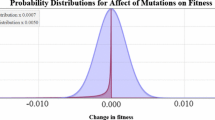Summary
At first we introduce a simple stochastic difference equation, to simulate random sampling drift in population genetics, which is naturally obtained from a random collision model. Next, we introduce a random collision model to simulate overdominance model in population genetics. We assume in a time interval °t, a random collision of four particles, which represents overdominant selection, takes place at a certain probability, where a particle corresponds to a gene. We assume that mutation takes place by some rate and assume that every new mutation is different from extant alleles. We estimate mean heterozygosity by our simulation method and compare it with the result obtained by using a stochastic difference equation for overdominance model.
Similar content being viewed by others
References
Ewens, W. J. (1964). The maintenance of alleles by mutation,Genetics,50, 891–898.
Ewens, W. J. (1979).Mathematical Population Genetics, Springer-Verlag, Berlin.
Itoh, Y. (1973). On a ruin problem with interaction,Ann. Inst. Statist. Math.,25, 635–641.
Itoh, Y. (1975). AnH-theorem for a system of competing species,Proc. Japan Acad.,51, 374–379.
Itoh, Y. (1979a). Random collision process on oriented graph,Research Memorandum No. 154, 1–20, The Institute of Statistical Mathematics, Tokyo.
Itoh, Y. (1979b). Random collision models in oriented graphs,J. Appl. Prob.,16, 36–44.
Itoh, Y. (1981). Non-associative algebra and Lotka-Volterra equation with ternary interaction,Nonlinear Anal.,5, 53–56.
Kimura, M. and Crow, J. F. (1964). The number of alleles that can be maintained in a finite population,Genetics,49, 725–738.
Maruyama, T. (1983). Stochastic theory of population genetics,Bulletin of Mathematical Biology,45, 521–554.
Maruyama, T. and Nei, M. (1982). Genetic variability maintained by mutation and overdominant selection in finite populations,Genetics,98, 441–459.
Maruyama, T. and Takahata, N. (1981). Numerical studies of the frequency trajectories in the process of fixation of null genes at duplicated loci,Heredity,46, 49–57.
Nei, M., Maruyama, T. and Wu, C. I. (1983). Models of evolution of reproductive isolation,Genetics,103, 557–579.
Moran, P. A. P. (1958). Random processes in genetics,Proc. Phil. Soc.,54, 60–71.
Pederson, D. G. (1973). An approximate method of sampling a multinomial population,Biometrics,29, 814–821.
Takahata, N. (1981). Genetic variability and rate of gene substitution in a finite population under mutation and fluctuating selection,Genetics,98, 427–440.
Wright, S. (1939). Statistical genetics in relation to evolution,Actualités Sci., No. 802.
Wright, S. (1949a). Genetics of population,Encyclopedia Britannica, 14th ed.,10, 111–112.
Wright, S. (1949b). Adaptation and selection,Genetics, Paleontology and Evolution, (eds. G. L. Jepson, G. G. Simpson and T. Mayr), Princeton University Press, Princeton, New Jersey.
Yokoyama, S. and Nei, M. (1979). Population dynamics of sex-determining alleles in honey bees and self-incompatibility alleles in plants,Genetics,91, 609–626.
Additional information
The Institute of Statistical Mathematics
About this article
Cite this article
Itoh, Y. Random collision model for random genetic drift and stochastic difference equation. Ann Inst Stat Math 36, 353–362 (1984). https://doi.org/10.1007/BF02481975
Received:
Revised:
Published:
Issue Date:
DOI: https://doi.org/10.1007/BF02481975




